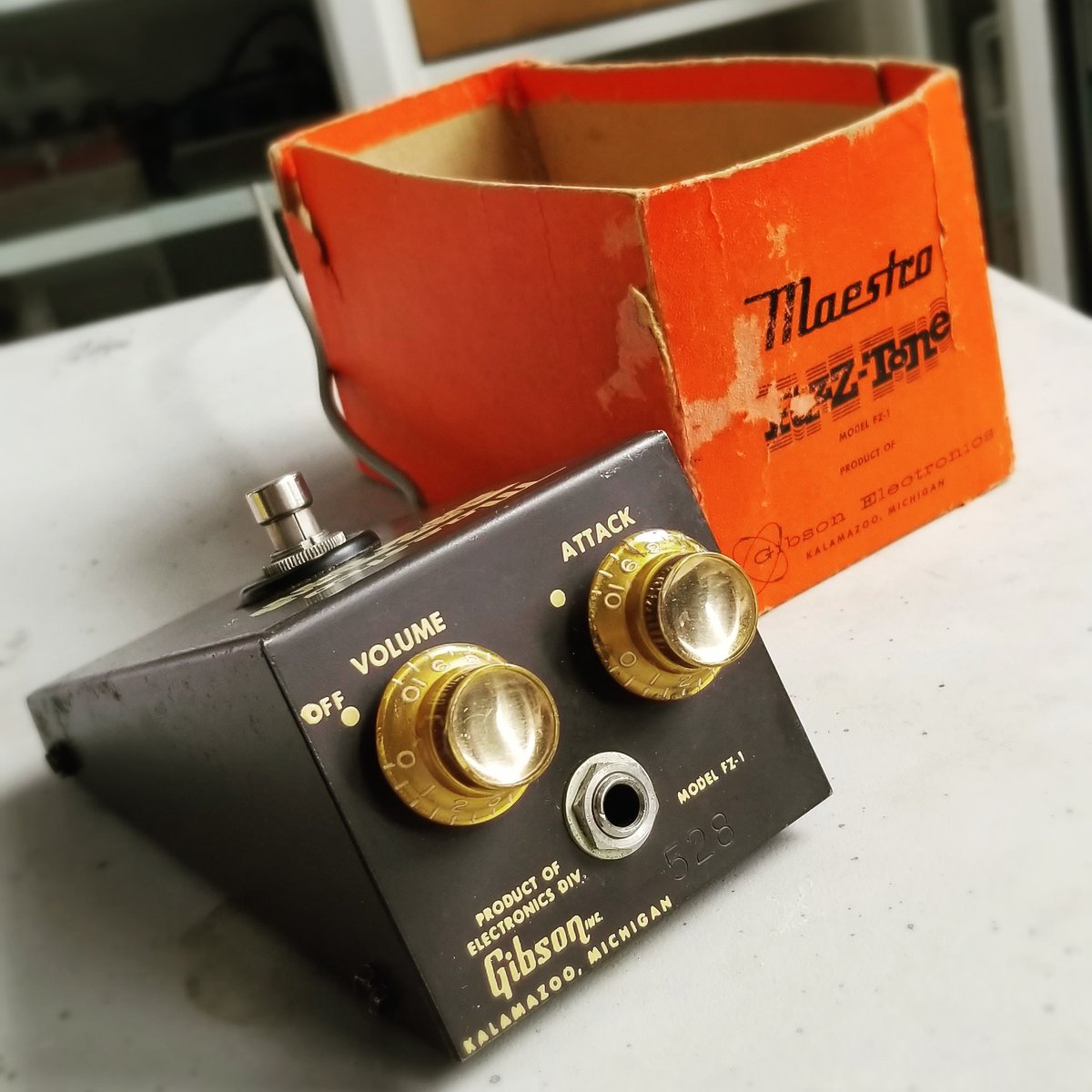ok, heres a quick story thread that falls within the "history of rock" that you probably haven't heard because frankly its super esoteric and isnt as engaging as Hendrix lighting a guitar on fire or whatever. pictured is a 1962 Maestro Fuzz-Tone, the first production fuzz pedal
...designed by Glenn Snoddy & a tv studio engineer named Revis Hobbs. it builds on a 1961 mistake made by a recording engineer named Grady Martin, who via broken console preamp, produced the distorted tic-tac bass tone at 1:28 of Marty Robbins 'Dont Worry'
(til this point, theres history of people pushing tube amplifiers, slashing their speakers with knives/nails to get different pushed guitar tones: Willie Lee Johnson, Link Wray, Paul Burlison, Ventures, etc... but outside of single one-off incidents, this was "mass production".)
Marty Robbins was like "i dunno guys", as "distortion" was not really a thing in music yet. so shortly after Martin was like "...noink" and used the same effect on his own song, called literally "The Fuzz", a novelty instrumental...
so Gibson, the guitar company, released Snoddy & Hobbs circuit as a production product to capitalize on this new sound. the fz-1 in 1962 and the slightly modified fz-1a a year or two later. my fz1 is a low serial number in the 500s, you'll notice the fz-1a is like 40,000 or so.
now a thing worth noting is that were all used to hearing distortion in the context of guitars, making guitars sound LIKE GUITARS! but if you look at the literature and promotional materials of the time, what they ACTUALLY wanted was to make guitars sound like brass instruments..
...they wanted long sustained bass'y *brass* notes, that natural shakey treble harshness. they even produced a 45 record to demonstrate these "exciting new sounds" never before played "organ like", "woodwinds" "booming bass" "bell clear horns"
that 45 first demonstrates a "sousaphone" effect on bass FIRST, then a "tuba" sound. etc. not screaming guitar leads, TUBA SOUNDS. hell, ten years later Maestro would release the "Bass Brassmaster", to give your bass guitar that hard stabby octavey horn sound.
the Bass Brassmaster got its own demo flexi, and theres even a typo where they wrote BRASS BRASSMASTER because theyre still on their horn kick. *to reiterate because this is important*, guitar distortion started with people trying to replicate TOOT TOOT HORN SOUNDS.
anyways, so people werent exactly lining up to buy this thing. but along came the @RollingStones, in 1965 Keith Richards is in the studio and he wants a horn section to double his lead guitar line melody on 'Satisfaction', but he cant get a horn section...
i dunno if it was a budget thing or what... so he gets a Maestro FZ-A, because it promises to make horn sounds and Keith wanted horns, and doubles his lead guitar with the unit as a temporary place holder for eventual actual horns (that never happen). heres Keith on the topic...
so the song comes out, smash hit, and everyone wants their guitars to sound like Keith Richards guitars, so Gibson instantly sells out their entire backstock in a year. mind you they had been sitting on THOUSANDS of them that went almost completely unsold for most of 1962-1965...
other companies swing into the mix to release their own fuzz pedals over the coming few years. notably guitar company Mosrite releases the Fuzz-Rite in '66, and the Guild guitar company releases the Foxey Lady Fuzz in '67. pictured is the prototype (far left) and a few variations
obviously the Foxey Lady is named after Jimi, who really hit in 1967. this is his '67 Dallas-Arbiter Fuzz face, which sold for like $40,000 at auction some years back.
in 1968 Mike Matthews, who had been working on The Foxey Lady pedals, starts making them for his own budding company Electro Harmonix. he names his version of the Foxey the AXIS fuzz, after jimi's '67 record 'AXIS: Bold As Love', this develops into the Big Muff...
...arguably the most famous distortion pedal of all time, variations heard on countless classic iconic records. Around this era the "FUZZ AS HORNS" approach was really abandoned in favor of "screaming big fuzzy guitar leads" being the idea. Rock Guitar, Punk Guitar, Metal, etc...
...so next time you hear a distorted guitar, Metallica or Nirvana or Pink Floyd or Marnie Stern or J Mascis or Sonic Youth, etc... i want you to think of a young grumpy Keith Richards in a studio just wanting a horn section but not being allowed a horn section.
toot toot.
/end
toot toot.
/end
[other than the Fuzz-Face, all the photos and units come from my personal collection/museum. I am *filled* with this kind of information and *surrounded* by historic guitar effects units but i so so so rarely get to talk about it. so this was more for me than you. xo.]
shameless thread tags. @EHX @gibsonguitar @jhspedals @oldbloodnoise @EarthQuakerDev @TymGuitars @guildguitars

 Read on Twitter
Read on Twitter














